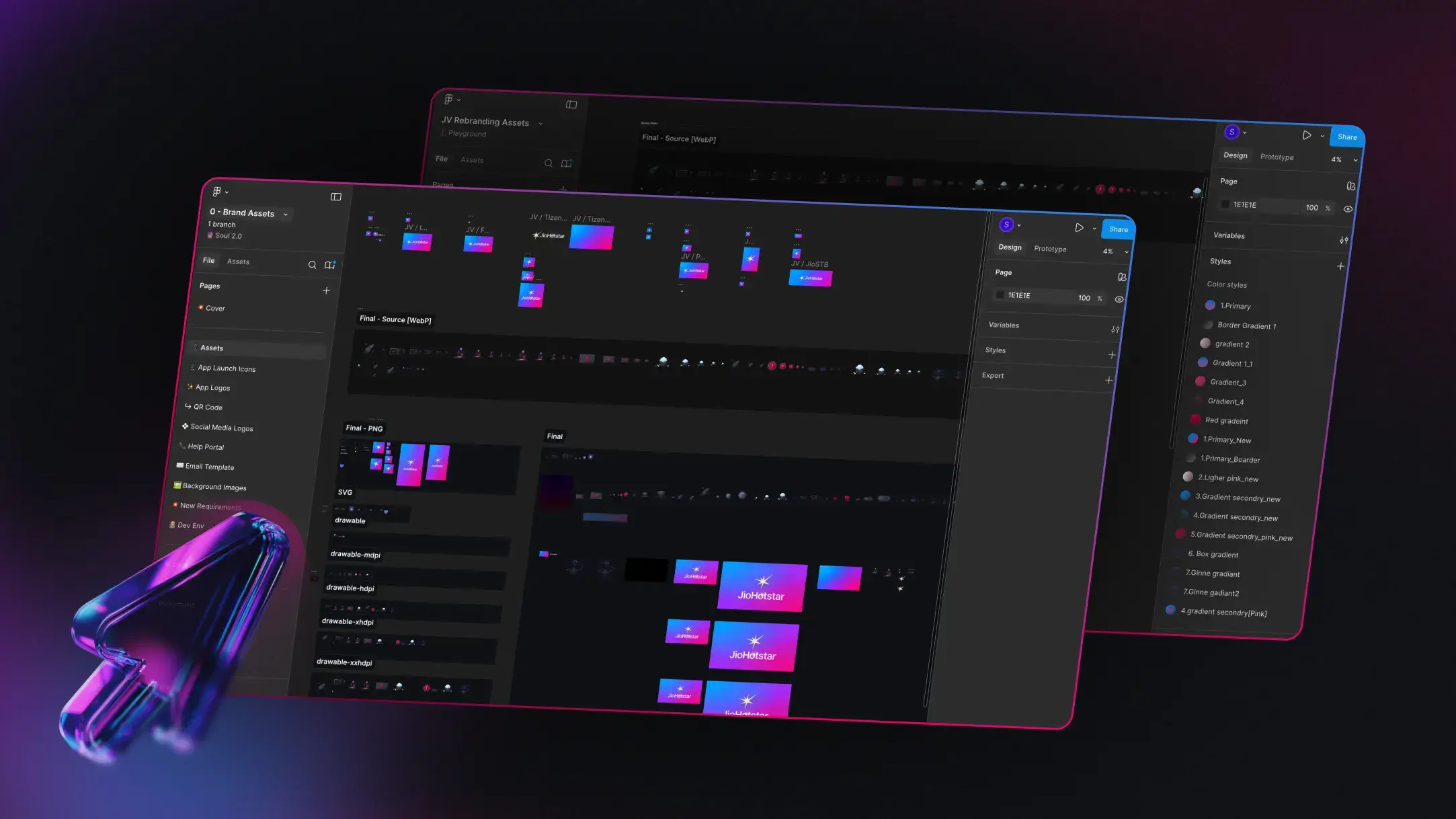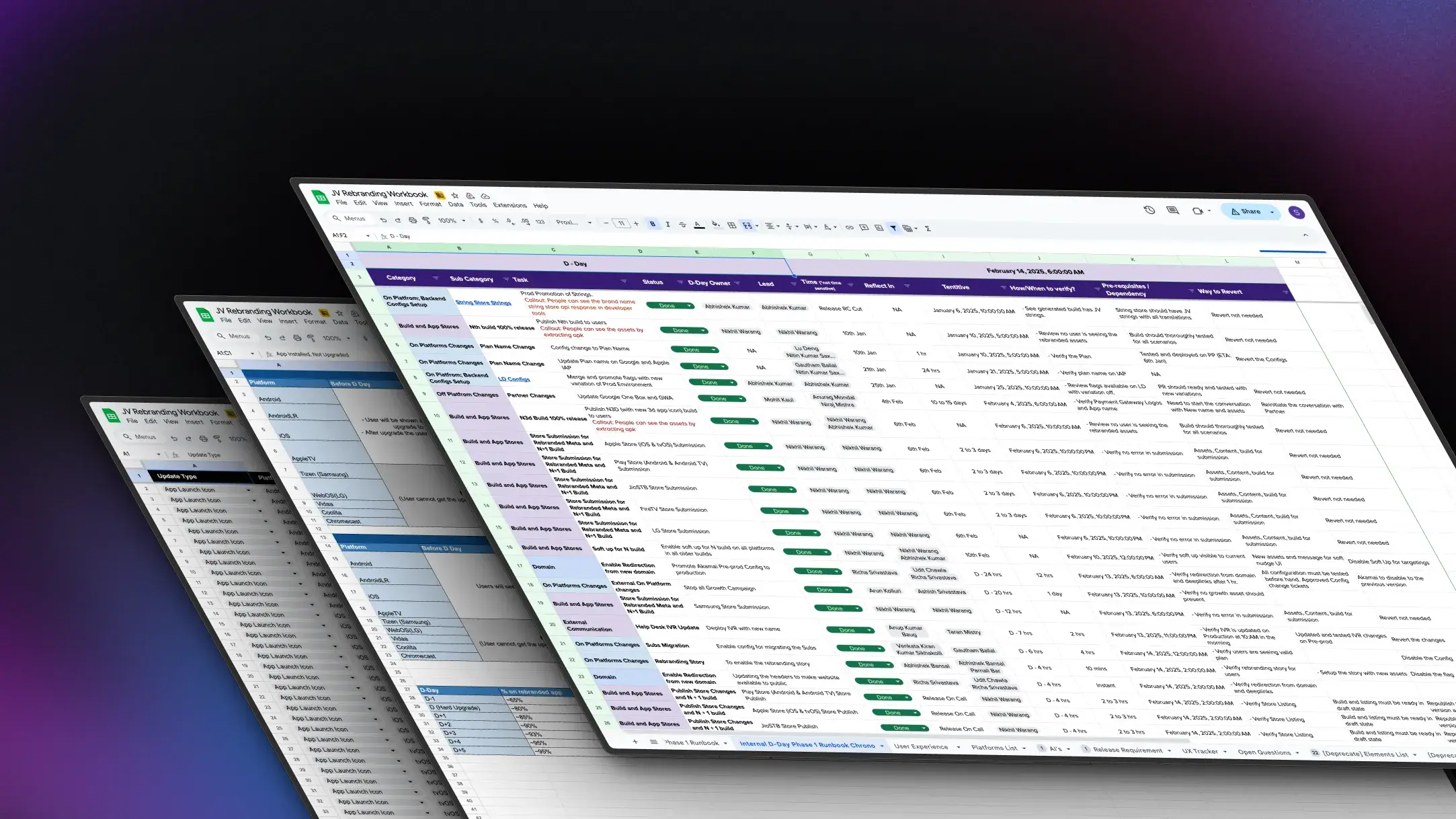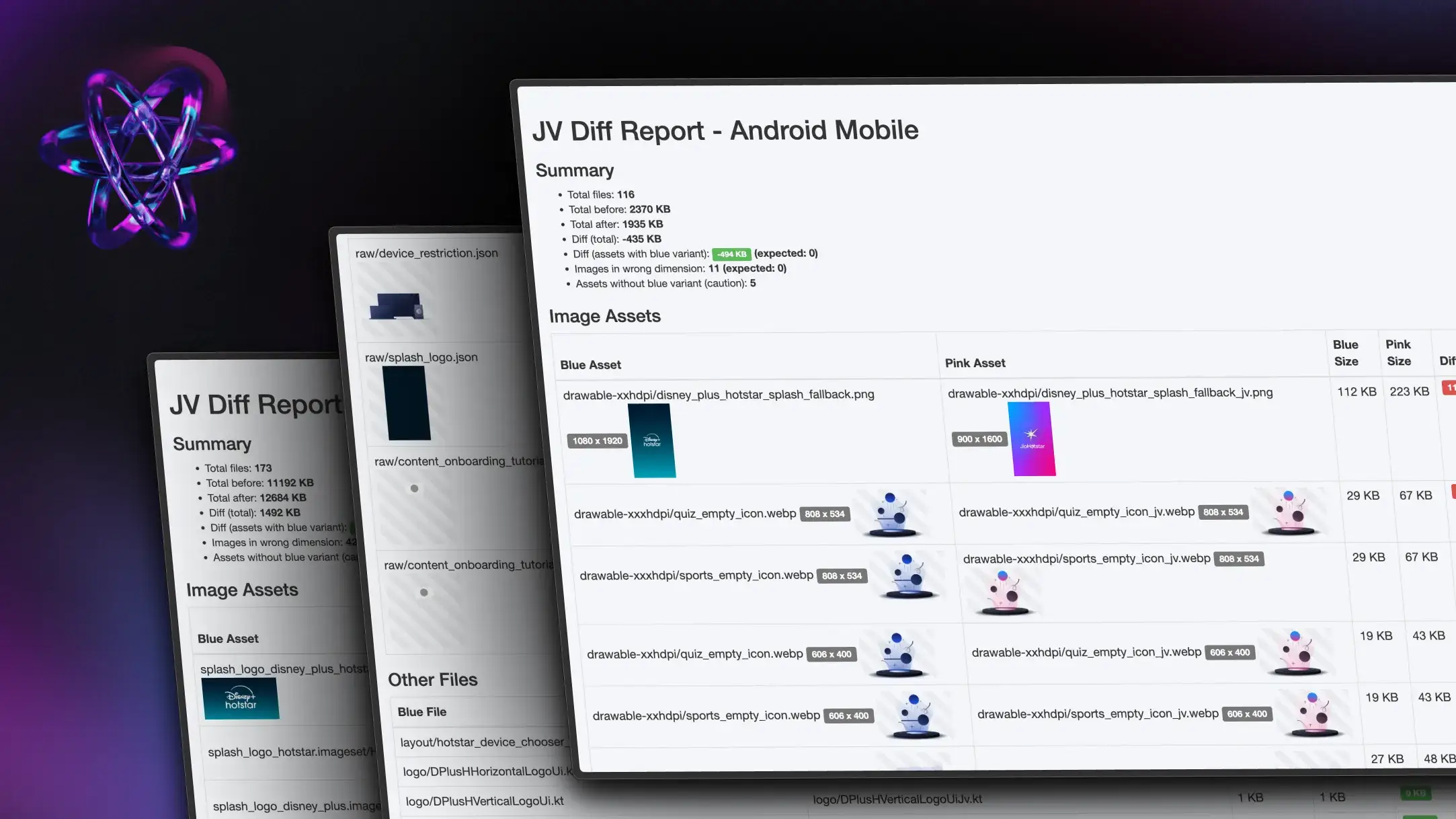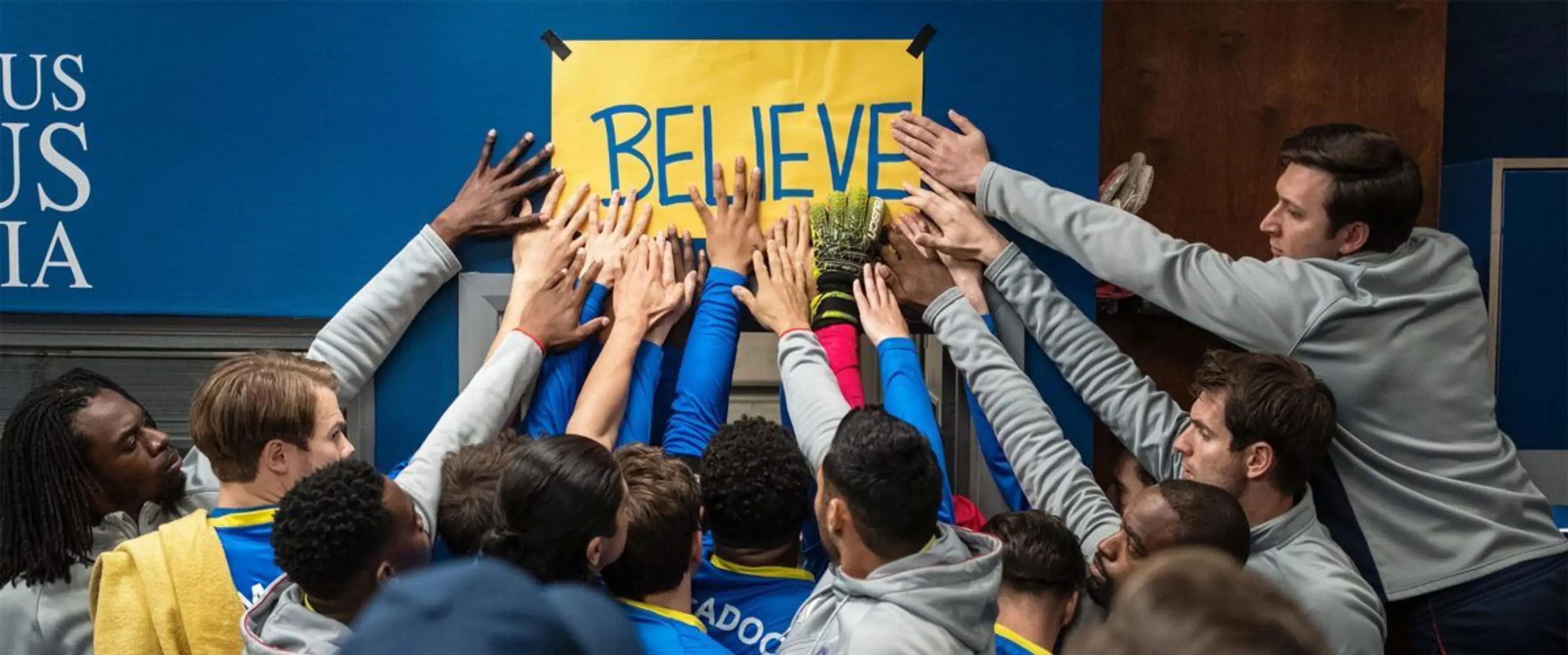JioHotstar Rebrand — The Chaos, the Craft and Letting Go

The Launch That Whispered
Feb 14, 2025 It was Valentine’s Day, but our heart wasn’t in roses or chocolates. It was in the faint, almost suspicious stillness that settled after we flipped the switches on what, on paper, was one of the biggest launches in digital history.
From icons and splash screens to user accounts and content libraries, everything began shifting in near-perfect sync — like stage lights coming on, one beat at a time. No lags. No misfires.
We were switching between Slack, the App Store, the Play Store, JioHotstar on the TV — refreshing every screen in reach, like stagehands checking cues before the spotlight hits. All the while, asking everyone on the team: did you get it? did you get the update?
Not because something broke.
But because, for once, nothing did.
No chaos. No Slack threads lighting up red. No last-minute fires. Just a weird, haunting stillness.
One misstep, and it would’ve been chaos. For a rebrand that merged two of India’s largest digital entities, re-themed 8+ different platforms, and went live for ~92 million users — the silence was unnerving.
It felt like the chaos had RSVP’d… and ghosted us.
Looking back, we realize the calm wasn’t luck. It was earned, one uncertain step at a time — through months of meticulous planning, cross-team coordination, and far too many final_final_jv_rebranding_v6 Figma files.
Though, in that moment, it felt like the orchestra had just finished the final note and no one clapped because everyone was still holding their breath.

What does it really take to rebrand India’s most-used streaming app — without breaking anything, losing users, or slowing down live matches?
This is the story of how we pulled it off. Not with heroics or luck but with systems that held, trust that ran deep, and a team that quietly owned every messy bit, together.
The Day JioStar Was Born — And The Real Work Began
November 14 wasn’t just Children’s Day. It was also the day the press release dropped.
JioStar — a new joint venture, or JV as we called it, between RIL, Viacom18, and Disney was official. Just like that, we were part of India’s second-largest media company — right after Google.
Inside the team, it felt equal parts exciting and ambiguous. We knew the merger meant JioCinema and Hotstar will come together to create a single, unified platform. But the how, when, and even what we’d call it were still up in the air.
There was no launch date. Just the reality: we had to prepare for a full rebrand, merge two mature apps, and migrate millions of users and content — seamlessly.
Plus, we had to do it with the platform running at full tilt — hosting two major championships, not compromising fan experience, adding new features, and supporting millions every day. No pause button. Just the usual chaos, dialled up.
From the outside, it looked simple. Swap some logos, update the splash screen, tweak a few configs and call it a day.
Inside, though, it was anything but simple. Systems tangled together, teams syncing in real time, and the path forward shifting under our feet. The truth was messy and anything but linear.
This wasn’t just another rebrand. It was easily the most complex overhaul we’d ever attempted — design, code, tooling, content, all moving at once.
Full-system surgery, and the patient was very much awake.
Crafting Clarity Through Chaos
The plan couldn’t wait for clarity.
So we began building through the blur.
We knew it wouldn’t be linear. What caught us off guard was just how much would keep moving as we built.
Specs shifted. Timelines slid. The logo changed. Animations kept evolving, right up to launch day. Swatches and theme tokens moved mid-sprint — sometimes minutes after we thought we were done.
This wasn’t just a logo swap or theme flip. It was a full-platform shift — screens, systems, surfaces, all of it. Every touchpoint, from splash screens to SEO tags, help portals to growth campaigns, had to carry the new identity and actually hold up under real scale.

We’ve lost track of how many files we touched. Hundreds? Maybe thousands. At some point, the numbers stopped mattering — the care behind each change was what stuck. The wildest part? We didn’t just do this once, or even twice — we ran the entire rebranding exercise three separate times, each as intense and all-consuming as the last.
Through it all, the product stayed live. No downtime. No regressions. No “sorry for the inconvenience” banners.
It felt like building inside a shape-shifting system — the shape never stopped changing. At one point, our tracking sheet had so many line items we had to split it into sections, and even then it felt unmanageable. So we stopped aiming for perfect motion and started building for repeatability.
We didn’t walk in with a playbook for chaos. Every script, every backup plan, showed up because something nearly slipped through the cracks. Most lessons, we learned the hard way — catching what wobbled, and making sure it wouldn’t next time.
Plan B? That was just the start. By the end, Plans C through F weren’t just backups, they were the real playbook. We weren’t chasing a flawless launch — we were designing for change. When the ground kept shifting, the system had to stay steady.
Design, Product, Engineering, QA — everyone orbiting a moving target, somehow landing together.

It was a bit like that Interstellar docking scene — everything spinning, no margin for error. The only reason it worked? We moved as one.
In the end, it wasn’t about pulling off a perfect launch. It was about staying steady while everything else kept shifting. About earning a little calm through chaos. And learning to build in ambiguity — not despite it, but through it.
When Coordination Becomes the Craft
Somewhere between shifting specs and moving flags, something shifted in us too. Teams stopped waiting for directions. We stopped trying to be everywhere at once. That’s when it clicked — the goal wasn’t control. It was coordination without control.
We weren’t just building flows or toggling flags. We were building for decoupled trust — a system where no one had to wait for permission, where ownership lived in rhythm, not meetings. Ambiguity wasn’t solved; it was absorbed. That was the real rebrand.
This rebrand didn’t run on escalation. It ran on alignment. Every track — Design, QE, infra, backend, comms, GTM — had clear owners, not just names on a spreadsheet. People flagged edge cases before they became issues, picked up missing bits without making them someone else’s problem.
There was no “war room.” Just a steady, almost quiet rhythm of teams solving, syncing, and shipping — without ever asking, “Is this my job?”
Ownership didn’t live in Jira. It showed up in judgment, late-night commits, quiet DMs, and the absence of noise.
It wasn’t about having a perfect plan. It was about a system — and a team — that could flex without fracturing. Everything moved, but nothing slipped.
Held Together by the Smallest Details
If this rebrand taught us anything — it’s that the devil isn’t just in the details.
The details are the system.
It wasn’t some grand system that held the rebrand together. It was the smaller things — the files, flags, scripts, and specs — that quietly kept the whole thing intact.
A Figma file that somehow stayed structured through three brand resets, still the single source of truth for assets. Another that mapped every user flow, edge case, and platform quirk, end to end.
Then there was the GTM sheet — a quiet kind of hero. It tracked every moving part in one place, updated daily, sometimes hourly. It didn’t just track surfaces; it told the story of where we actually were, what was ready, and what still needed hands. No fanfare, just steady clarity in the middle of the mess.

Those late-night pings about whether the watermark should show up on VR360, or if a background shade was off by one. The kind of details that never make it to launch notes, but quietly keep the seams from splitting.
Behind the scenes, automation did the heavy lifting. Scripts processed over 700 assets — icons, illustrations and lotties — toggled 150+ flags, swept strings, validated performance, and flagged mismatches. Not once. Not twice. But three times, just to be sure.
In Android alone, 1,293 files changed. 58,000+ lines of code added, 21,000+ removed. No drama. No heroics. Just deliberate change, shipped with care.
However, it was the team’s care that caught the smallest anomalies — a splash animation lagging on low-end devices, an app icon failing on older iOS versions. Nobody waited to be told. People moved with shared context, solving things before they became problems. That, more than anything, made all the difference.
The System Was Strong. The People Were Stronger.
Tokens gave us alignment. Automation gave us momentum. Flags kept it controlled. Docs caught the edge cases. Tooling did the rest.
But none of it would’ve mattered if people weren’t holding the seams.
The system didn’t save us.
It supported us.
But it was the people who made it land — and hold.
Designers, Researchers, Engineers, PMs, QA, Marketing, Ops, Business — everyone held their end, even as specs kept shifting mid-sprint. Ownership didn’t need to be assigned; it just showed up, quietly and consistently.
Teams that kept our Figma assets sharp through three brand resets — structure steady, even when direction wasn’t.
The GTM sheet only worked because our program team and engineering leaders were relentless — updating, nudging, and keeping the rest of us honest as things changed by the hour.
The Product Design and Research teams built every flow, touchpoint, and edge case — working through shifting priorities without losing pace. Product, Marketing, and Business teams kept everyone in sync real-time — not just on what was done, but what was still moving.

Scripts swept assets end to end, compressing days of effort into minutes. String updates were automated, so consistency held even under pressure. The QA teams? They tested, re-tested, and re-tested again — not for credit, but because they knew what was at stake.
App store timelines, build cutoffs, launch flags — all landed on time. Assets changed. Deadlines moved. But quality held. People stepped in, solved things in motion, and kept the bar high.
This was just a glimpse. People saw what was needed, and stepped in. Behind every flag was a decision. Behind every asset, a conversation. Behind every build — a check, a catch, a quiet fix.
Everyone moved — with care, with context, with craft. Not because someone was watching, but because the system let them watch out for each other.
Leadership Means Letting Go (On Purpose)
We didn’t realise it at the time. But watching the team move — with context, with care — was the moment, our leaders, let go.
Not from burnout. Not from detachment. But from quiet, deliberate trust. The kind that sneaks up on you, not with a grand gesture, but with the realization that the team no longer needed your shadow in every thread.
Starting out, one feels that leadership meant presence. Being on every Slack thread, preempting fires, holding the torch and the glue. Jumping in at the first sign of drift — part guardian, part bottleneck.
However, when true ownership springs, thats when true leaders emerge. The brand specs landed after weeks of revision, the deadline shifted, plans were rewritten — even when leaders weren’t everywhere. Teams just did the right thing, because we all believed.
Everything just held. Not because we handed things off better. But because the system held. The team picked up judgment, made calls, flagged risks, rescoped the work, and kept the bar — without being asked.
Our best leaders? They stayed out. Not because they had to. But because they chose to.

There’s a line from Ted Lasso:
I believe in hope. I believe in ‘Believe.’
The entire episode was a master class in leadership for all of us. Belief, for the longest time, felt like a feeling — something soft, maybe even a little optional.
However, watching the teams steer through chaos, it landed: belief isn’t just sentiment. It’s structure. It’s the system that lets you step away without worrying it’ll all fall apart.
Letting go wasn’t about stepping back. It was about getting out of the way — on purpose. It was because we trusted the people, their craft, and what we’d built together.
What Held, What Helped & What We’ll Take Forward
Looking back, the real win wasn’t that the rebrand didn’t break anything.
It was that the system held even when the brand kept shifting. That people didn’t wait to be told. That the calm wasn’t luck — it was engineered through thoughtful systems, quiet ownership and a structure where ambiguity could be absorbed, not feared.
We didn’t just leave with a rebranded product. We left with a playbook — a way to move fast, move together, and still move well.
A system where ownership didn’t need permission. Where context mattered more than control. And where stepping back wasn’t a risk — it was the proof that the design had worked.
Maybe that’s what real leadership is — building something strong enough that you no longer need to hold it up yourself. Learning, every time, to trust a little more — in the system, in the people, and in the quiet proof that it can hold without you in the room.
Into an Era of Infinite Possibilities
Fast forward to today — the product didn’t just scale, it blitz-scaled.
The IPL 2025 season became our most extraordinary yet: over 300 million subscriptions, record-breaking watch time, and revenues that placed us among the world’s digital giants.
However, beyond the numbers, what truly mattered was the way this experience brought people together. We didn’t just stream cricket; we sparked a movement that united fans across every screen and corner of the country. More than a milestone, it became a defining moment — a glimpse of access, scale and what India’s digital future might feel like.
Yet, the most profound success was quieter. Every platform held, every flag toggled, every stream seamless. No relaunch, no fireworks. Just a product that kept growing because the foundation was built to last. The system held strong, and the people behind it remained vigilant, always ready for what might come next.
That was the launch. But this — this is the landing.
Welcome to Infinite Possibilities.
Originally published on JioHotstar Blog